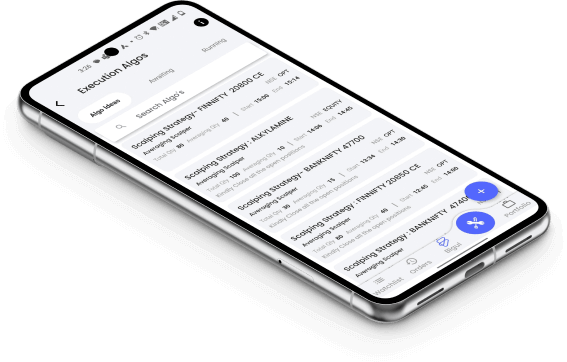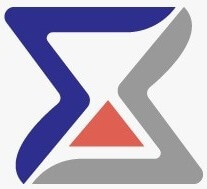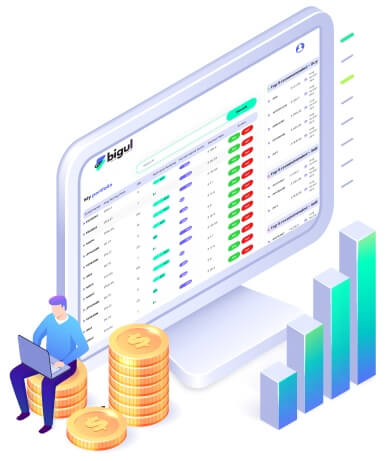Open an Account & Start Algo Trading Today!
- Flat Rs 18 brokerage
- No Cost Algo Trading
- Trade from Chart
- 30+ Indicators
- Stock SIP
- Smart Case
- Bigul Option Chain
- 300+ Pre Defined Market Watch
- IPOs
- Basket Order
Best Indicators for Intraday Trading
The key to intraday trading is time.
This makes it necessary for traders to quickly make decisions on the best entry
and exit tactics. This is why technical indicators are important.
These Indicators assist in observing trends, price ranges, and volatility developments as they occur. In order to minimize risks, they make the necessary use of intraday trading by using the right indicators.
In this article, we will focus on some of the intraday trading indicators that every day trader must learn and why you should not ignore them in your efforts to stay ahead of other stock traders.
What are Intraday Trading Indicators?
The intraday trading indicators are
instruments that are concerned with live analysis of the stock market in
pursuit of trading opportunities and market opportunities that will lead to
earning profits. The indicators assist in determining the trend of the market,
whether it’s bullish or bearish, the price trajectory, and its momentum and
some prospective points for entering and exiting trades.
These tools come handy in assisting the traders to identify any such short-term course of price movement which can be leveraged on as well as the occurrence of such price movements on the same day.
These indicators include, but are not limited to, moving averages, oscillators and different types of volume related signals. Because there are a number of different indicators, traders combine them to confirm the signals and improve their trades, which is especially useful in managing risk in intraday trading.
Importance of Intraday Trading Indicators
Intraday trading indicators prove to be effective tools for the traders who carry out buying and selling of securities within one day. Let's see a few of them:
1- Quick Decisions: Unlike ordinary indicators, intraday indicators generate data within the timeframe which allows a trader to act in a timely manner. Decisions are of importance in trading since a good decision made within time can ensure profit.
2- Understanding the Market Dynamics and Price Charts: Price and volume indicators are sophisticated tools that help an intraday trader to analyze market trends and price charts, providing an understanding of optimal buy and sell price levels. This is important when attempting to take advantage of quick price movements.
3- Risk Control: Intraday indicators help the traders to incorporate the stop-losses and other methods of protecting their capital. By applying risk control, the trader is most likely to preserve his or her capital, thus reducing the potential risks.
4- Understanding of Technical Indicators: For intraday indicators to be effectively used, there is a need to comprehend technical indicators. This kind of knowledge enables the traders to make better trading decisions by analyzing charts and patterns.
5- Algorithmic Trading: With the improvement of the technologies, the intraday indicators are more frequently applied in algorithmic trading within the day. This way, there is an option to do trades automatically, thus improving the efficiency of performance made by the trader.
Best Technical Indicators for Intraday Trading
This practice requires knowing the
most effective technical intraday trading indicators in order to earn gains in
quick trading activities. Let us, therefore, consider the best indicators that
are commonly used by intraday traders.
1. Relative Strength Index (RSI)
RSI or Relative Strength Index is
considered one of the best indicators for intraday trading. On the other hand,
the RSI can also be used in day trading to discover if the stock is being
traded too high or too low.
RSI always varies between 0 and 100 and at a low track of 30 indicates that a stock is currently in an oversold region. When the reverse applies, meaning an RSI above 50 it is thought that too many stocks are trying to be purchased.
RSI which is above 50 indicates that stock has gained enough bullish momentum over selling pressures hence influences the price upwards. In other words, when there is an increase in SSE RSI is a good plausible indicator as well of the increase in the stock price. Depending on the RSI, intraday trading strategies can be revised on the run.
2.
Moving Averages Convergence/Divergence (MACD)
Moving averages are to day traders what oxygen is to a living being, making moving averages one of the favorite tools for day traders regarding technical analysis. Moving averages come in handy when determining the direction of a market or a stock, and possible corrective fluctuations. You can use it to determine whether the price is trending towards or away from the mean price, which is commonly used to measure bullish or bearish trends.
Such Types of moving averages concept can be implemented in terms of simple moving average (SMA), weighted moving average (WMA), Exponential moving average (EMA) and Moving Average Convergence Divergence (MACD) are relative concept of each of the above moving averages or in some of them own for intraday.
The most striking feature of the moving average in intraday trading is its ability to signal the correct positions to take for a given trade. Using the crossover, between the MACD line and the signal line you can decide whether to buy or sell.
3. Exponential
Moving Average (EMA)
EMA is another variation of the
moving average where greater weights and importance are attached to the recent
data points. This makes the EMA less responsive to the price changes over a
longer period than the Simple Moving Average (SMA). Due to this attribute, EMA
is widely used by day traders requiring fast execution.
Also, EMAs help to indicate the trend as well as where a trend might likely change. For example, a bullish idea can be formed when the shorter period EMA crosses into the zone of the longer period EMA. This indicates the prospects of entering a long position after some time. On the contrary, a streak is said to become bearish when a lower EMA crosses back down below a higher EMA. Hence telling the trader it is time to exit.
This way, intraday traders can form an opinion on the trend of the market and choose the right moment to pull the trigger to buy or sell.
4. Bollinger Bands
The Bollinger Bands are an element
of technical analysis pioneered by John Bollinger which is extremely popular
today. This element is composed of three lines: the central band which is the
20-day simple moving average; the upper band which is placed at +2 standard
deviations from the SMA, and the lower band which is at -2 standard deviation
from the SMA. Such bands demonstrate the price changes of the stock. The price
has a wide margin when it is volatile, whereas the price has narrow margins
when it is less volatile.
The traders of a day watch out for the Bollinger Bands to understand the movement range and volatility of a particular stock. Touching the widget of the upper band indicates an over-stretch on the stock as a sell moment is presented. Moreover, when a stock price reaches the lower band, it shows that it is most likely that stock prices have been driven down too low which indicates a buy level.
The active traders who depend on the upper and lower bound for their trade, are able to buy when price reaches the upper bound, and sell when the lower bound is touched.
5.
Accumulation/Distribution Line
One of the indicators most
recommended for intraday trading is the Accumulation/Distribution Line (A/D
line). It serves to measure the money inflow into the stock. A/D line works
like On Balance Value; however, it does not limit its analysis to one closing
price of a stock. Instead, this approach also incorporates the entire trading
range for a useful period along with the closing price of the stock within that
range.
Where the A/D line trend appears to be up, this means buying pressure is present, and this is proved as the stock price in this case has been closing above the middle of the price range thus confirming the bullish trend. But the opposite is true when the A/D is falling as the price will be closing within the bottom section of the daily price range and thus the volume is negative and also a bearish trend.
It also, for some divisions, can predict reversals; for trends reversal, people look for divergences where the A/D goes down but the price goes up signaling that trouble is brewing and normality may no longer be there. Similarly, price movement decreases and the A/D value increases. This points to the likely prospect of high prices coming in.
6. Stochastic Oscillator
It is a type of technical analysis tool used to measure momentum in trading activities which is more useful for non-professional or non-advanced level traders looking for short term events to profit from in trading. It involves intraday trading activities. Therefore, to execute a day trade with more profitability, it is also essential to know the class of stocks' general market activities at different times or periods. Stochastic oscillator shows from the point of view that compares the close of any stock for a given time period for a range of prices to be.
On the glimmer of stock price, if the price of the stock moves to its long-term high price and the oscillator levels do not oscillate as well, it implies that the demand is being depleted, albeit gradually. From an intraday view also it makes a great indication that the price of stock is likely to drop.
The stochastic Oscillators fluctuate from 0 to 100 when the stock goes up, a new peak is obtained. In a downtrend when the price is trying to go lower than the previous low, the stochastic will follow and try to see whether this will be tested. As such the stochastic can also serve as an indicator of overbought and oversold space where levels that are less than 20 quickly become oversold while those between 80 to 100 are overbought.
7. Parabolic SAR
The Parabolic SAR (stop and reverse)
is a technical analysis tool that focuses on the current direction of the asset
as well as any potential reversal. It takes the form of dots on the price chart
either above it or below it. Dots below the pricing chart represent bullish
movement of an asset whereas dots above it signify bearish movement of an asset.
As the trend proceeds, they continue moving closer to the price, and when they
cross the price, it indicates that the price might reverse.
However, the Parabolic SAR is used by day traders to define trailing stop-loss orders. With this technique, they can move the stop-loss order up and ‘follow’ the price, thus securing the profit whenever the price moves in the right direction.
Furthermore, the Parabolic SAR has proven effective in a trend, as it tends to extend the duration of profitable trades and enables timely exits.
8.
Pivot Points
Pivot Points are a type of technical
analysis commonly employed by day traders in an effort to forecast possible
reversal points. The calculation of these levels usually includes the highest
and lowest prices and closing prices of the previous trading sessions.
Pivot Points are useful to know the orientation and possible reversal action enabling correct moves in entering and exiting positions.
The principal Pivot Point consists of average value which is obtained from the previous trading day’s high, low and close. This main Pivot point has additional support and resistance levels that are derived to give the wider picture of the price action of the market within a certain period.
To maximize the capabilities of the Pivot Points, traders utilize these areas by marking them on their charts and wait for the price levels to interact with them. For example, when the price trades above the primary Pivot Point, it implies that there is an upward price expectation and this could be a suitable time to buy. On the other hand, if the price is ailing behind the Pivot Point, then it is safe to assume that they are biased in the downward direction and this could be a good time to short.
“Combined with Other Indicators” - this is the view of the majority of serious traders. For them, especially traders using Pivot Points for analysis, the volume and the moving average can add value to the confirmation of the trade.
9.
Commodity Channel Index
CCI is another multipurpose oscillator that can help detect the tendency of the stock to deviate from its average price over a period of time. It also helps to determine where the stock is: if it is in an overbought or oversold position and how much ability or pressure is available for reversal of the current trend. During an intraday business, the traders look at the levels of the underlying asset and try to project the possible trend in the changes of the price of such an asset.
The commodity channel index consists of values like 0, +100 or -100, however, it is clear that a positive value means there is an uptrend while negative means that there is a downtrend in the market. And the better way of using CCI and RSI together helps you in understanding the overbought and oversold status of the stock in the market.
CCI helps the trader gauge the extent of price movement from the predetermined baseline or the normal price level and is also used in detecting fresh trends in the market.
Conclusion
Choosing the appropriate indicators is one of the most important aspects if you wish to increase the level of efficiency in intraday trade operations. Indicators like Moving Averages, RSI, Bollinger Bands and MACD allow traders to recognize the trends, reversals and price actions very fast. They help to minimize the risks and improve accuracy of trades. If you wish to achieve the maximum effect, then you should take a number of indicators since this is the better way of looking at the market. Keep in mind that though indicators are helpful, there is a need to practice proper risk management for long term success in the volatile world of intraday trading.
FAQs
1. What is the difference between an
intraday technical indicator and a long term one?
Intraday indicators are useful for
studies of rather short intervals, perhaps only hours and minutes rather than
days and weeks. They signal when to enter or exit the position within the scope
of intraday trading which is very rapid in nature, while long term indicators
tend to capture the movement of prices over a much longer duration.
2. Is it safe to depend on only one indicator when performing intraday trading?
No, it is dangerous to stand on a
single indicator. Many assets providers have two or several systems in order to
filter their signals and minimize false positive events. It seems that these
two indicators do complement each other as far as clarity is concerned.
3. Are there any indicators that work well in volatile markets?
Yes, Bollinger Bands are a great
option for volatile markets. They measure price volatility and help traders
identify potential breakouts or breakdowns, which are common in highly
fluctuating markets.
4. How can volume indicators improve my intraday trading?
Volume indicators, like On-Balance
Volume (OBV), help confirm price movements. If a price moves up with increasing
volume, it shows strong momentum. If volume is low, the trend might not last,
signaling a possible reversal.
5. Do intraday technical indicators work for all asset classes?
Yes, most intraday indicators work across asset classes like stocks, forex, and commodities. However, it's essential to adjust settings based on the specific market’s characteristics, such as volatility and liquidity.
Also Read:

Download Bigul Trading App!
Supercharge your trading on the go with the Bigul Trading App! Download now for instant access to cutting-edge features, real-time insights, and unparalleled convenience.













